
Why Does The US Military Trust LASIK?
For a lot of people, having LASIK means seeing well without requiring or depending on glasses and contacts. We see a lot of personnel from the U.S. military enquire and receive eye laser treatments especially LASIK in Los Angeles. The U.S. trusts LASIK eye center in Los Angeles like Excel Laser Vision Institute for many laser vision correction procedures.

The military receives laser treatments because service members require exceptional vision for operational success and safety. Although a civilian can appreciate, enjoy, and probably needs perfect vision, for military personnel in combat situations or when landing a fighter jet on an aircraft carrier, excellent vision can mean life or death.
Some service members have to tolerant harsh environments that have dust, sand, dust, smoke, and flying debris. These conditions make corrective lenses, whether they are glasses or contact lenses, counterproductive and even unsafe.
Because of this, the U.S. Department of Defense carried out its own research into the growth of laser vision correction procedures, such as LASIK, to assist their personnel in attaining the outstanding vision required to perform their duties no matter where they have to serve.
Studies On LASIK Surgery For The Military
Eye surgeons performing LASIK in Los Angeles have read some studies that analyzed the military’s readiness of 360 active duty service members before and after eye laser correction surgery.
The study assessed factors, such as, “weapons sighting ability” and “ability to function at night.” In all instances, performance indicators enhanced after surgery. The following is what data revealed after laser vision correction surgery:
- Fifty percent of the study’s participants got better performance scores on “overall individual readiness”
- Eighty-six percent improved their scores concerning the “ability to utilize night vision goggles”
- Forty-one percent claim that they had a better ability to contribute to the unit’s mission
- Over ninety-eight percent of the study’s participants said they would have the surgery again.
- Further study revealed that pilots landing on aircraft carriers at night saw better with less glare than they did with glasses.
Nowadays, the U.S. military is one group that highly requests laser vision correction procedures like LASIK in Los Angeles. Furthermore, the U.S. Food and Drug Administration partnered with the Department of Defense in the first division of the Patient-Reported Outcomes with LASIK, or PROWL study to scientifically certify a questionnaire that provides patients an accurate and complete method to report their experience with LASIK to researchers. Most importantly, the military division of the PROWL study reported a very successful satisfaction rate with LASIK, around ninety-eight percent.
Similar to military personnel, a majority of emergency responders such as police officers and firefighter are requesting laser vision correction, for instance, LASIK eye surgery. They are asking for laser eye surgery because they want to perform their jobs more safely and effectively. Even though normal civilians may not have the same requirements to protect and serve their communities, if you are considering laser vision correction, check out the commonly asked question about LASIK eye surgery down below.
What Is LASIK?
LASIK is an abbreviation for Laser-Assisted In-Situ Keratomileusis (LASIK). It is an innovative technology that reshapes the cornea to reduce and even eliminate the visual irregularities that result in nearsightedness (myopia), farsightedness (hyperopia) and/or astigmatism.
The LASIK procedure helps light to enter the patient’s eye so they can properly focus onto the retina for clearer vision. Many patients have reported that they see better after a LASIK procedure than with their glasses or contacts.
Typically, LASIK surgery is pain-free and only takes about 15 minutes for both eyes. As a result, the eyesight is improved without the dependence on eyeglasses or contact lenses. As soon as the procedure is complete, the vision is noticeably improved and will stabilize over the next few days. If your eye surgeon feels that you are not a good LASIK candidate, there are other vision correction surgeries, such as PRK and LASEK eye surgery.
Is LASIK Surgery Safe?
If you want to do LASIK surgery, but are afraid to, you shouldn’t be. LASIK is a very safe and effective vision correction option. As a matter of fact, contact lens wearers will probably freak out when they find out that LASIK is safer than contact lenses. Some clinical data has revealed that the risk of vision loss because of infection is a lot higher with contact lenses than LASIK.
Over 19 million LASIK procedures have been carried out in the United States alone with immense patient satisfaction in visual results. The successful rate of patient satisfaction, which is over ninety-six percent based on recent clinical data, is because of the extremely low risk of complications from the surgery. According to research into the clinical experience with LASIK, the ratio of complications from LASIK eye surgery is about less than one percent, which makes LASIK the safest elective surgical procedures available.
Here are a few more facts from studies that patients find comfort in when considering LASIK surgery.
From 1993 to 2005, over 9,000 patients have participated in FDA clinical trials testing LASIK safety and outcomes.
Ever since then, a massive quantity of clinical research into LASIK has been implemented. Currently, more than 7,000 peer-reviewed published studies have confirmed that LASIK is not only effective but also safe. Also, they have delved into the important aspects of LASIK.
This broad scientific evidence includes studies that help improve what makes a patient a suitable or unsuitable candidate for a LASIK procedure and techniques and technologies that can lessen the possibility for side effects such as dry eye, glare, and halos.
What Type Of Surgeon Is Good For Me?
Obviously, a surgeon who is highly qualified such as Dr. Moosa at Excel laser Vision, who has over 25 years of experience in performing eye laser treatments such as all-laser LASIK, SMILE, PRK, Contoura-Topo guided LASIK and wavefront-optimized all-laser LASIK.
LASIK is the most popular laser vision correction surgery for the military, and even civilians can benefit from the safe and effective results LASIK surgery can provide. If you want further information about LASIK eye surgery, give Excel Laser Vision Institute a call at + (818) 907-8606 today.

How LASIK Works
Almost 20 years ago, the FDA approved LASIK surgery and it has not stopped being a hot topic for better vision. Even if you don’t know much about LASIK, you can probably hear yourself or others reference it in your daily life. It is the answer to improved vision through the help of a LASIK surgeon in Orange County.
However, even though you might think LASIK is the answer to your vision issues, it isn’t for everybody, and it does not fix every vision issue.

What Are The Basics Of LASIK Eye Surgery?
First of all, not many people know that LASIK is actually an acronym for laser in situ keratomileusis and is a two-step procedure.
A LASIK surgeon in Orange County would make a micron-thin, circular flap in the cornea, which is the surface of the eye. It does not take the surgeon long to do this, roughly a few seconds and then he or she uses either a microkeratome or a femtosecond laser.
Afterward, the surgeon slowly lifts the flap and then the actual vision correction treatment will take place, which is just under the surface of the eye.
During the second step, a surgeon of LASIK in Orange County uses a computer-guided excimer laser to permanently remove the microscopic pieces of tissue which are causing the patient’s vision issues.
Then the flap is put back in place to act as a natural bandage and protect the reshaped portion of the cornea while it heals.
Ever since the first LASIK eye surgery was approved by the FDA, over nineteen million LASIK procedures have been performed in the United States alone.
Furthermore, LASIK has acquired more than forty-five FDA approvals, treating myopia, hyperopia, presbyopia, hyperopia, presbyopia, astigmatism, and many other eye conditions.
Are Lasers Shot Into Your Eyes?
It sounds very sci-fi, but yes that is what happens and it is pretty neat! Before you start to freak out, you should know that lasers are a beam of light that move together within the same wavelength at various speeds. For instance, the femtosecond laser that is sometimes used to create the flap is an infrared laser that pulses at one quadrillionth of a second to create microscopic tissue disruptions inside the cornea. The excimer laser which is used to correct the patient’s vision is an ultraviolet beam with a pulse rate of up to 1000 Hz.
Nowadays, lasers are used in various types of surgeries because they are amazingly accurate. This is very important since people hear about LASIK “slicing” and “dicing” the eye. These descriptions are not really precise. The whole LASIK procedure happens completely within the layers of the cornea, and no other part of the eye is involved. This is achievable because lasers can be used safely without harming the surrounding tissues.
Is It Painful?
You do not need to worry about pain because LASIK is typically painless! Numbing drops are used to anesthetize the eye before and during the procedure of a LASIK surgeon in Orange County. Normally, patients feel some pressure from the eyelid holder that the surgeon uses to prevent blinking, but other than that patients are made comfortable with the numbing and lubricating drops. After the procedure, some patients experience some mild discomfort that usually only lasts for about five hours.
Are You Awake During The Procedure?
Yes, and some people freak out about this, but you shouldn’t! Besides the numbing drops, your doctor can give you a sedative to help you stay calm. Also, the fact that you are awake does not harm you in any way. If your eye moves, the laser’s tracking capabilities follow your eye. If you sneeze or move around too much, the laser is capable of switching off automatically when this happens.
Is LASIK safe?
This is the most asked question our eye surgeons get and it is a good one to ask. Over the years, LASIK has been the most research elective procedure. Over 7,000 clinical studies have been conducted and published about LASIK. As a result, there has been a massive amount of data supporting its safety and effectiveness.
Also, LASIK eye surgery has one of the highest patient satisfaction rates compared to any other elective procedure. On average it rates at over 96 percent.
A majority of LASIK patients remark on how their vision is way better than when they had to wear glasses before surgery.
In over 40 million procedures around the world, there has never been a case of blindness because of LASIK in anyone who is a healthy, suitable candidate.
Are There Side Effects?
It is common to experience some symptoms during the healing period after a LASIK procedure. At the end of the day, it is a surgical procedure even if it only took fifteen minutes. It is normal to have this recovery period and your eyes might feel a little dry, sensitive to light, or irritated while they heal. Let your doctor know about your symptoms during your post-LASIK visits.
A few patients experience side effects from LASIK which consist of night vision visual symptoms such as glare, halos, ghosting, starbursts, and dry eye. Normally, glare, halos, ghosting, and starbursts slowly go away by themselves over a period of a few weeks or months, maybe as long as a year. Some patients may need extra courses of eye drops to lower the inflammation and/or dry eye that can cause visual symptoms.
In rare circumstances, less than five percent of the time, additional LASIK treatment may be recommended to fix residual vision issues or you can wear thinner glasses or contact lenses.
Who Can Have LASIK Eye Surgery?
If you have thin or irregular corneas or suffer from a certain eye disease such as glaucoma, your eye surgeon will probably inform you that you are unsuitable for LASIK.
Some autoimmune diseases such as lupus or rheumatoid arthritis, and medications such as corticosteroids, can impair the healing process and are not ideal for certain laser correction vision procedures.
If you want more information about LASIK, do not hesitate to give Excel Laser Vision Institute a call at (818) 907-8606, or fill out our contact form today!
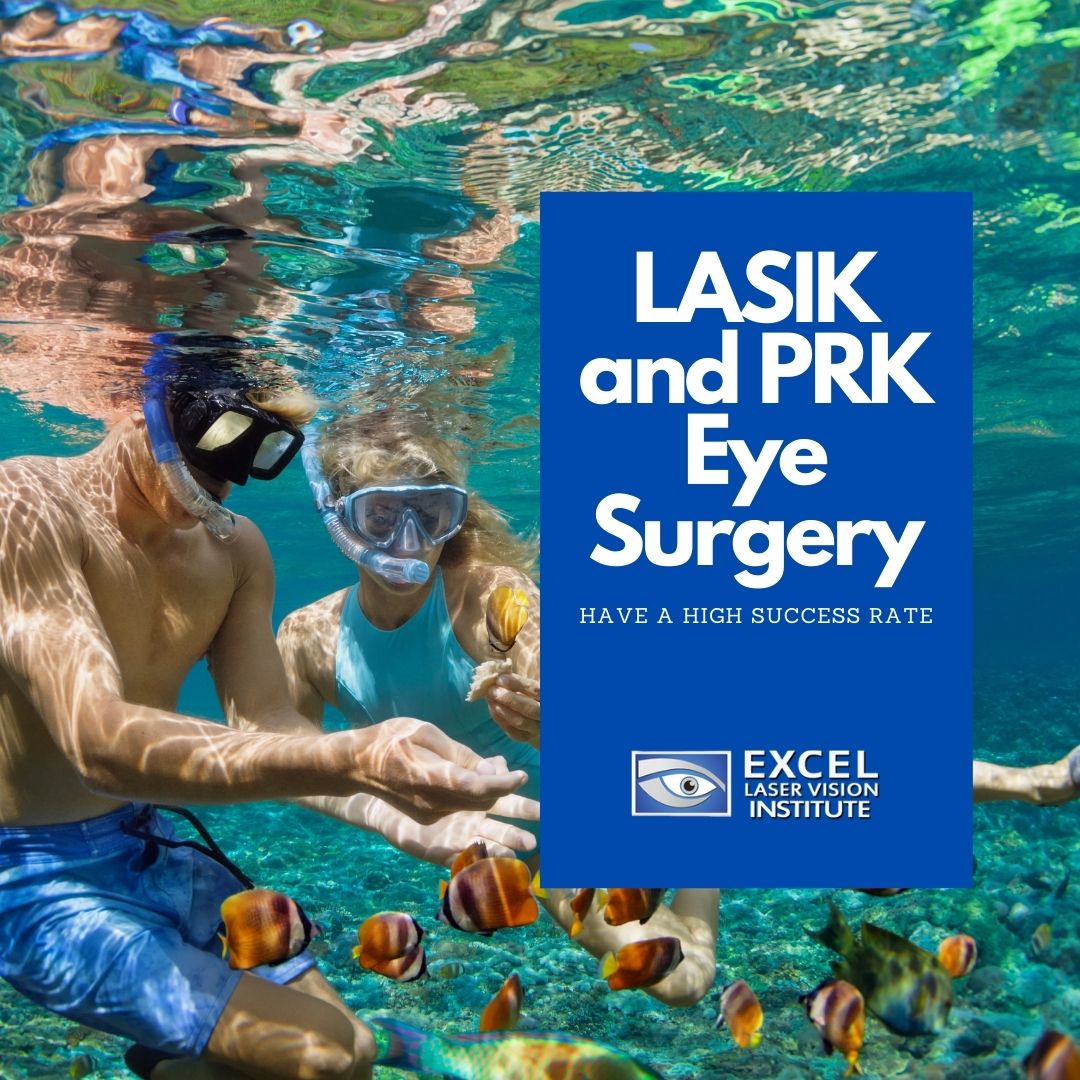
The High Success Rate of LASIK
Surgeons performing LASIK in Los Angeles always say the number one question that patients have is about the success rate. That is completely understandable. Nobody wants to go through the hassle and financial burden of eye surgery if it does not give them the results they are expecting.

Recent research claims that ninety-nine percent of patients achieve better than 20/40 vision and more than ninety percent of patients achieve 20/20 or better. Furthermore, LASIK has an extraordinary 96 percent satisfaction rate at the LASIK eye center in Los Angeles such as Excel Laser Vision Institute, which is the highest of any elective procedure.
If you are considering a vision correction procedure, understanding the LASIK and PRK eye surgery success rate is a critical component of your research as well as getting to know what these standards signify for your own vision goals.
Figuring Out The LASIK Success Rate
So, let us answer the most common question asked about LASIK in Los Angeles: What is the LASIK and PRK eye surgery success rate? LASIK, PRK, SMILE, and other refractive surgery results depend on several factors, such as visual acuity, and the patient’s general satisfaction.
What Is Visual Acuity?
This refers to the sharpness of your vision. It is a fixed measurement that is normally taken in a doctor’s office while you are sitting motionless. Many consider 20/20 vision, which is the ability to read the eye chart at 20 feet, to be “normal”. Nevertheless, if you managed to score 20/20 vision on your visual acuity exam, it does not necessarily mean a high quality of vision for everyone.
There have been instances where some people define the quality of vision to be levels of clarity, contrast sensitivity, reaction time and other factors.
Researchers have examined LASIK patient satisfaction including how pleased patients are with their vision and how it has affected their quality of life. When mentioning the LASIK success rate, it is also vital to understand possible risks and complications.
When we refer to the LASIK success rate at the LASIK eye center in Los Angeles like Excel Laser Vision Institute, these are the only measurements that count: Does it achieve your vision goals? Does the LASIK surgery give you what you want? Do you find that your lifestyle and career have improved because of it?
Understand What Matters
Research on patient satisfaction after surgery reveals that the most important factors are whether the surgery meets the patient’s expectations. To find your personal LASIK success rate, you have to honestly ask yourself what you anticipate out of your laser vision correction surgery. So, ask yourself the following questions:
- Why are you expecting to achieve after LASIK?
- How do you think LASIK surgery will improve your life?
If you are feeling overwhelmed, just sit yourself down and jot down a few of your expectations. This will come in handy for you and your surgeon performing LASIK in Los Angeles to figure out the best course of action for you.
Many people have heard a lot of positive things about LASIK and PRK in Los Angeles and expect it to improve their lives. However, they usually don’t take a long, comprehensive look at what that signifies – what LASIK can help them do, or do better, or enjoy more. Understanding your personal vision goals helps to define your LASIK success. Additionally, it helps out your eye surgeon immensely since he or she can understand why you want LASIK, and how to guide you through your LASIK experience and set the proper expectations.
Do You Know Why You Want LASIK?
Different people have different reasons for wanting good or even excellent vision. If you have vision problems, there are several reasons to think about LASIK.
For some, LASIK success might mean getting rid of their glasses. Perfect vision could also be important for your current job, or the one you are dreaming of.
When you initially think about success, you think about your career. Therefore, it is not a surprise that people turn to LASIK to do better at their jobs, or land their dream jobs.
For instance, if you are a police officer, firefighter, EMT or another first responder, you will need excellent eyesight. Also, those jobs mean working in the toughest of conditions, and often times it is impossible to wear glasses or contact lenses.
Police who are in pursuit might enter dangerous circumstances and requiring your vision to be at the highest level. You could be putting yourself at great risk. What about a firefighter that has to endure the smoke, water, and steam? If that sounds like you, LASIK success could mean being able to do your job in tough conditions such as fires and arrests, without the hassle of eyeglasses or contact lenses getting in the way.
Pilots who are in military combat and supporting roles, in airlines and overall aviation, need the best eyesight possible since it is a matter of life and death.
As a matter of fact, the Navy and Air Force were the first adaptors of LASIK to make certain the pilots with the best overall qualifications were not excluded because of their vision issues. How would you measure your LASIK success as a pilot? By the ability to do your job and make your passion for flying a reality.
You don’t have to have a heroic profession to consider LASIK. Even photographers are interested in sharpening their vision since it will make it easier for them to use their cameras, and produce better images.
If you have a major life event happening such as graduating from college, getting married, starting a family (running after small children with glasses on isn’t easy) or you are going on a new adventure, LASIK is for you! Laser eye surgery can help you achieve your vision goals, start a new career or hobby, and enhance your overall quality of life.
Get in touch with one of our eye surgeons for more information on our LASIK and PRK treatments in Orange County. Call Excel Laser Vision Institute at (818) 907-8606 today to change the way you see life!

Recovery Time After LASIK Eye Surgery
So, you want to get LASIK surgery, but you aren’t certain how long you might need to stay home while you take some time to heal. At the LASIK Orange County clinic like Excel Laser Vision Institute, our surgeons understand that returning to school, work, and everyday activities play a huge role in a person’s life.

A majority of managers and business owners are supportive and even sympathetic when workers ask for time off to improve their vision. Below, our LASIK surgeon in Orange County answers some of your questions about how fast you can expect to go back to your routine.
How Long Should You Stay Home After LASIK Surgery?
Although you will notice that you can see much clearer after leaving our LASIK surgeon in Orange County, it is necessary to have a good, long nap so you give your eyes the rest they require right after LASIK surgery. If you watch television, use a computer or other devices too early after your laser eye surgery procedure, they can cause your eyes to strain. Generally, your eye surgeon would want to have a brief follow-up visit the day after your procedure to make sure you are healing properly.
What Happens During LASIK Eye Surgery Recovery?
Laser eye surgery is a minimally invasive surgery, that after receiving the treatment, besides the improved and glasses or contact lens-free vision, there are no other signs that it ever even occurred.
Many people believe that there is an immense level of pain that you have to endure during eye laser recovery, but that is not the case. You might feel a slight watering and stingy sensation, and there is a feeling that something is right in your eyes for a couple of hours after your eye correction surgery. This is why the LASIK surgeon in Orange County advises their patients to nap as soon as they get home after LASIK surgery to cope with these symptoms.
This mild discomfort is easily managed with eye drops that your eye surgeon will provide for you.
As soon as you wake up, you will place the eye drops in your eyes and maintain this routine for several weeks. By the next day, patients usually feel that their eyes are much clearer, even though they will continue to stabilize for the next three to six months.
How To Get Back To Work During The Recovery Process?
Normally, people expect their surgeons to tell them it can take weeks, months, or even years before they can get back to work. However, laser eye surgery is far from your normal surgery. This is very apparent by the fact that the majority of patients return to work as fast as 24 hours after their treatment.
Relying on factors like specific treatment, the anticipated recovery rate, and if you had a morning, afternoon or evening procedure, many patients take about two days off, which are the day of the surgery and the day after. This is usually the case after LASIK surgery.
Quickly returning to work is usually not a problem for many patients. Nevertheless, when you return to work, there are some things to keep in mind to encourage recovery.
Nowadays, many people work indoors with screens, the primary thing that surgeons tell their patients is to keep their eyes well lubricated with artificial tears; especially if you are using a computer and you are in an air-conditioned environment since both can dry out your eyes. Also, it is good to be aware of the fact that you blink less often when you look at a computer screen.
It is important to take extra care if you work, for instance, on a construction site, where there is a higher risk of dust and debris entering the eye. Wearing safety glasses and taking other appropriate precautions are a good way to avoid this from happening and causing irritation or any needless complications.
On the other hand, if you are one of the fortunate ones to work outside in the sunshine, wearing sunglasses with 100 percent UV protection is essential for the first few weeks of recovery and is usually good eye care advice to follow further on.
How To Get Back In The Driver’s Seat After Laser Eye Surgery?
Since driving and controlling a car is highly reliant on your eyes, many people it will take a while after LASIK until you can get back in the driver’s seat.
However, if you are like a lot of patients, you can drive again in less than 24 to 48 hours after treatment. For a majority of people, this is generally an intense experience as you begin to view driving and being out on the open road with fresh, “new” eyes. Also, it can feel shockingly strange and freeing to be behind the wheel without having to wear your glasses.
The precise time you are back to driving really depends on the treatment you had and the clinic you go to. A majority of patients can legally drive the first day after surgery and is usually the case for 95 percent of patients and treatments except for PRK. It is during the consultation you will have a day after with your eye doctor that he or she will advise you whether or not your vision meets the driving standard and can sign you off.
Once your doctor gives you the ok, you can drive, but for the first few days, it is best to drive short distances and be mindful of things such as starbursts and halos around lights while driving at night.
These side effects are normal and are a normal part of the eye’s recovery process, with many people experiencing them as very mild and many not even observing them at all.
During the first 24 hours after treatment, you should arrange for a friend or family member to drive you home while you take the back seat.
If you have more questions about what an eye surgery recovery process involves, give Excel Laser Vision Institute a call at + (818) 907-8606 to talk to one of our eye surgeons today.

How Long does Eye Surgery Lasts?
According to the LASIK surgeon in Orange County, many LASIK surgery procedures take place on a daily basis. LASIK stands for laser-assisted in situ keratomileusis and is a type of refractive procedure that can remedy eye conditions such as myopia, hyperopia, and astigmatism. The aim of LASIK is to lower the patient’s dependence on glasses or contact lenses. However, many patients would like to know the burning question: How long does LASIK last?

Does LASIK Have Long-Lasting Results?
To put it short and sweet, yes LASIK lasts long, and in fact, it can last a lifetime. The purpose of LASIK surgery is to give patients suffering from poor or blurry eyesight the ability of clear vision. Corrective eye surgery is a good option for patients suffering from blurry vision, but when the surgery takes place can significantly affect the long term results.
If a patient has LASIK surgery between the ages of 18 to their mid-thirties, there is a higher chance of positive, long-lasting results. During this age range, the eyes are still healthy and are less likely to change after surgery. When a patient is over 40, corrective eye surgery is still possible, although the results they have to depend on corrective lenses for activities such as reading because of presbyopia.
LASIK can eliminate the temporary fix of corrective lenses and support the permanent freedom of clear vision. This is how LASIK can affect you in the long term.
How Long Does LASIK Last If You Do It When You’re 18 to Late 30’s?
When you are thinking about having eye surgery from the LASIK surgeon in Orange County, taking your age into consideration can mean the difference between having a clear vision for years and returning to corrective lenses. There are some main elements when deciphering if this moment is the perfect time for you to undergo treatment.
A person’s vision will probably keep changing until they reach their mid-twenties. Prior to surgery, the patient’s vision must remain stable for two years. If a patient’s vision has not remained steady before surgery, the procedure will most likely not totally correct his or her vision.
This could lead to a higher risk of blurry vision in the future. When someone is in their late 20s, they are usually more financially stable and responsible which makes it a lot easier to set up payment and vision recovery is a lot more successful. LASIK surgery within this age range will usually last a lifetime.
How Long Does LASIK Last If You Do It When You’re in your late 40’s to Early 80’s?
LASIK in Orange County is a long-lasting solution for poor, blurry vision regardless of age. Although, it is best for an individual to receive LASIK before they reach their mid-40s. Also, just like the rest of the body, a person’s eyes age and can develop new conditions that result in complications.
After eye surgery, many patients recover with clear vision but might need glasses for reading or driving at night. Nevertheless, these conditions may go away after a month or two post-procedure.
A lasik surgeon Orange County can use surgery to correct blurry vision, but it cannot protect an individual’s eye from the effects of aging. While you age, a person’s eyesight starts to blur again. You shouldn’t be concerned about this since this is a condition known as presbyopia. A person’s vision won’t go back to what it used to be, nonetheless, they may require to depend on glasses for activities like reading.
What Is Presbyopia In Middle-Aged Patients?
Another concern to think about regarding presbyopia is that it is a continuously diminishes a person’s ability to focus on nearby objects. This is the reason behind the fact that so many people start to wear reading glasses or bifocals when they reach middle age. Patients who have LASIK before they become presbyopic will require reading glasses to see things up-close. Another option for reading glasses is a laser vision correction known as monovision.
Furthermore, even though you had LASIK, your eyes are still susceptible to other eye conditions such as cataracts or glaucoma.
What Are Cataracts In Elderly Patients?
It is normal for elderly patients to get cataracts, cloudiness of the lens inside the eye that causes diminishing vision. Ordinarily, this happens when patients reach their 70s or 80s, but it can occur at any age.
During a successful cataract surgery, the eye surgeon removes the cloudy lens. Then, he or she replaces the cloudy lens which was removed with a new, flexible, artificial lens. This brings back pre-cataract visual acuity.
LASIK alters the shape of the cornea to focus light sharply on the retina. While outcomes are different for every patient, the procedure lets many to enjoy many years of clearer eyesight.
Does PRK Have Longer Results Than LASIK?
In the Journal of Cataract & Refractive Surgery, a study was published regarding the evaluation of long term stability of PRK, which is a laser vision correction procedure that is very much like LASIK.
British researchers examined the vision of 45 PRK patients for a span of eighteen years. Before surgery, all patients were nearsighted, with an average eyeglass prescription of 4.86 D (range: -2.75 to -7.37 D).
Patients who were younger than 40, when they did a LASIK procedure, had an average regression of – 0.54 D during the 18 year investigation period. Individuals who were over the age of 40 that undergone LASIK had an average regression of only -o.o5D.
Ever since its development, LASIK surgery has helped thousands of patients receive clearer vision. While the outcomes vary from person to person, LASIK has demonstrated to be an effective and permanent alternative to corrective lenses.
Some eye surgeons have an additional cost for a LASIK enhancement surgery, and this could depend on how soon after the initial LASIK procedure the enhancement is performed and the policies of your LASIK surgeon or clinic. If you want further information about LASIK enhancement surgery, give Excel Laser Vision Institute a call at + (818) 907-8606 today.
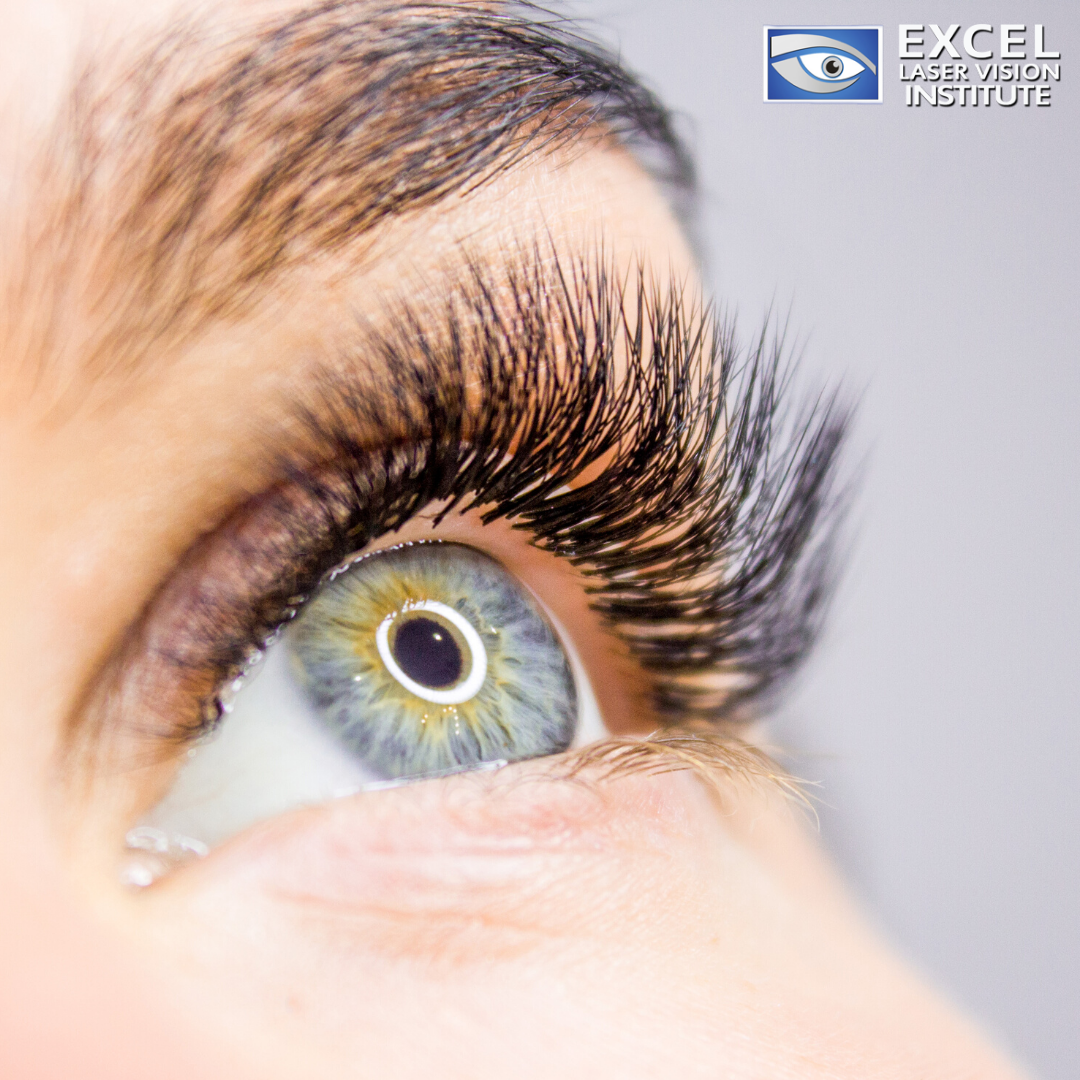
Why Some Require Additional Surgery
Eye surgeons performing LASIK in Los Angeles use the most optimum lasers and machines to provide all patients with state-of-the-art science and innovation that can provide 20/20 vision. The success rate at the LASIK eye center such as Excel Laser Vision Institute is very high because we are the local leader in LASIK treatment.
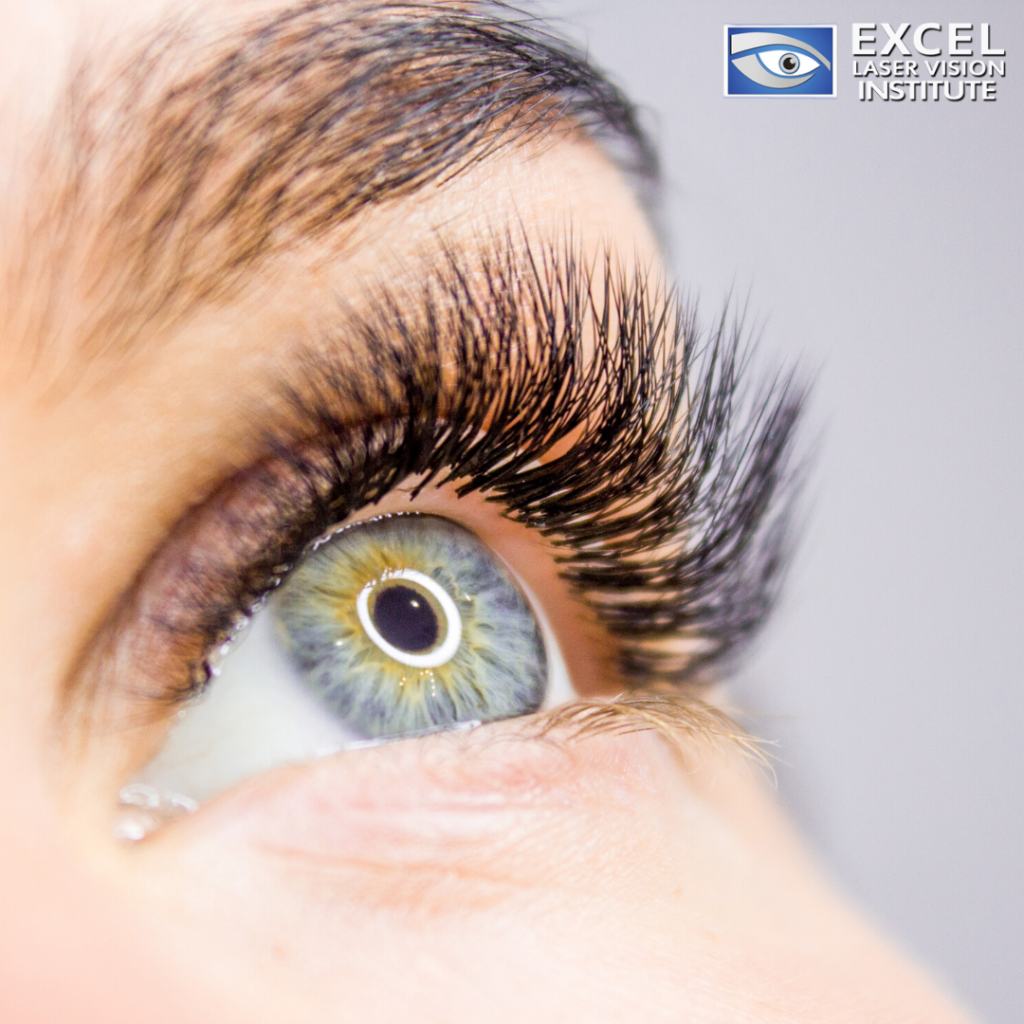
Can You Have More Than One Eye Laser Surgery?
Although you might have heard otherwise, laser eye surgery is permanent. The eye surgeon uses a high precision laser to make a permanent modification to the patient’s corneas, in a process that cannot be reversed.
Despite the fact that the natural aging process of the eye might affect this permanent procedure, which can change and may even reduce a patient’s vision over time. Which makes a lot of patients ask the question – Can you have more than one eye laser surgery?
In a nutshell, the answer is yes, but it isn’t that easy. Each case is different and when dealing with something as crucial as eyesight, intense care should be taken to make sure patients are suitable for treatment.
Does Lasik Eye Surgery Have A Low Complication Rate?
According to the American Academy of Ophthalmology, more than 90 percent of patients attain 20/20 to 20/40 vision. Eye surgeons performing LASIK in Los Angeles increase that estimate by using the most advanced innovations in our eye clinics.
Technically, your eye surgeon can assess the patient’s particular condition before telling the patient whether he or she can perform the surgery. Similar to all surgical processes, there is a factor of risk involved, even though this factor is very small for laser eye treatments, so the eye surgeon will have to make sure all elements are determined.
Fortunately, laser eye surgery has very high success rates but 2 to 3 percent of cases might need a second procedure right after the first. A variety of circumstances including the patient’s eyesight, age and genetics can signify that the eyes under or overheal.
This can make the patient experience blurred vision, glare and a bit of distortion. Typically, these types of symptoms disappear in a couple of weeks after surgery but continual blurring may mean that the initial surgery has not been 100 percent effective. Our experienced and qualified eye surgeons performing LASIK in Los Angeles have a much lower repeat procedure rate than other clinics but particular conditions do signify it is sometimes necessary.
If a patient needs a follow-up treatment, your eye surgeon will examine your corneal tissue and further correct it to enhance the patient’s eyesight. In many cases, the result is very successful.
Is It Possible To Have A Second Eye Surgery?
There are many reasons why patients requiring LASIK in Los Angeles would require a second laser eye surgery. Every patient has to be examined separately, so a professional opinion is needed to ascertain whether a person should have a second eye laser surgery procedure. It is all determined by the quantity of tissue in the eye and how much of this was removed during the first eye laser surgery.
What Is The Safety Of Multiple LASIK Procedures?
LASIK is thought to be a safe procedure, Over 95 percent of patients who undergo LASIK surgery are happy with their results. As mentioned before, LASIK just like any other surgical procedure has some risks involved, such as visual disturbances like halos, glares, starbursts, poor night vision, and difficulties figuring out contrast, dry eyes and maybe even vision loss.
Some of these negative side effects clear up on their own in a few weeks to months of undergoing a LASIK procedure. Normally, long-term issues related to LASIK are very rare. Undoubtedly, when a patient undergoes more than one LASIK surgery, the risks double and the rate of complication subsequently increases too.
Normally, there is no limit or a particular number of times a person can undergo LASIK surgery. The main element in establishing a candidate for LASIK enhancement and secondary surgeries is the size and thickness of the cornea.
LASIK uses special lasers to produce a thin flap in the corneal tissue to get to the stroma, or internal part of the cornea, to vaporize and alter the cornea’s shape to correct refractive errors. The shape of a person’s cornea is what leads to nearsightedness, farsightedness or the reason why they suffer from astigmatism. LASIK can correct all of these refractive errors that make it a problem to focus and see clearly.
When patients undergo enhancement surgeries the eye surgeon has to harvest more corneal tissue, and at some point, the patient will not have enough. Every LASIK surgery will make the cornea thinner. If the eye surgeon sees that there isn’t enough tissue to work with, LASIK is not possible or a safe option.
Your eye doctor will measure the thickness of the patient’s cornea to figure out if he or she is suitable for LASIK at first and in the case of any enhancement surgeries. If the ophthalmologist finds that the patient’s cornea is too thin, a laser surgery procedure like PRK can still be performed.
What Happens To The Eyes During The Natural Aging Process?
Even though many patients still declare that they have at least 20/25 vision ten years after surgery, the muscles that control the eyes normally weaken with age. This may be a sign of conditions such as short-sightedness has come back.
If you feel you are having to depend on your glasses more and more for reading or driving a few years after surgery, it might be possible to go through further corrective treatment.
If a patient’s corneal tissue is thick enough, and an array of other health requirements are met, it is possible to have a second procedure with very little risk. Certainly, the eye surgeon can advise the patient on their suitability for treatment.
Every time laser eye surgery is performed only a small amount of corneal tissue is removed, each time the pulse of the laser removes an amount which is a tiny fraction of a human’s hair width. This means that second treatments are possible, however, it is crucial that not a lot of tissue is removed, since it does not grow back and cannot be replaced.
What Is The Likelihood Of A Second Laser Eye Surgery?
In the case of a patient that has under or over healed, or because of regression occurring in their eyesight, the possibility of requiring a secondary treatment at any point is almost nil. Less than 5 percent of patients need some kind of follow up or additional procedures in their lifetime, with a staggering number of patients reporting immense improved eyesight years after surgery.
As you age, you might discover that you begin to depend more on your glasses and lenses again, but this is 100 percent natural and typical to essentially everyone, whether they had eye surgery or not. However, in many cases, this isn’t an adequate reason for secondary eye surgery.
Although LASIK is the most popular laser vision correction surgery, you should follow your eye doctor’s advice and guidance on whether LASIK is the best procedure for your requirements. If you want further information about LASIK or PRK, give Excel Laser Vision Institute a call at + (818) 907-8606 today.
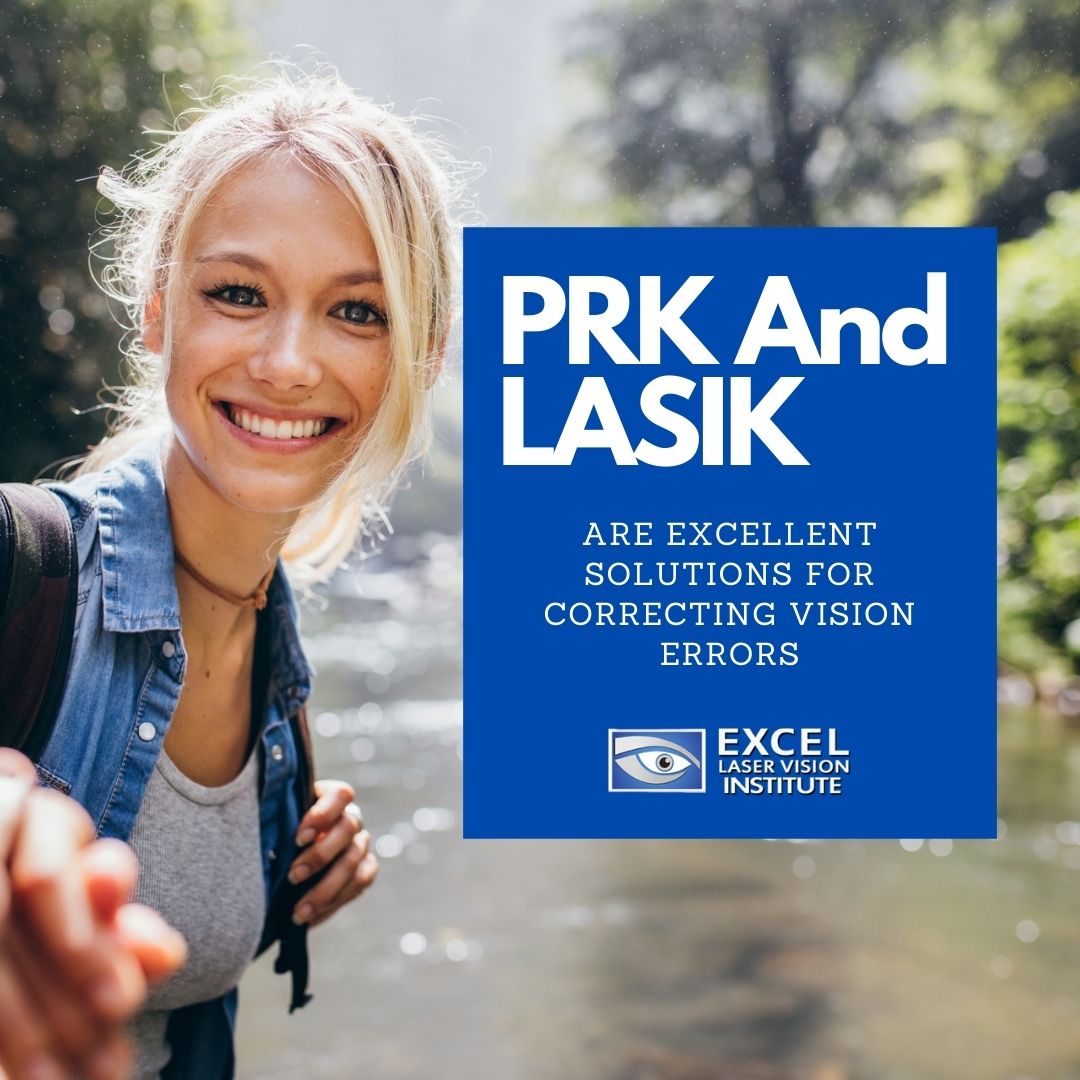
LASIK OR PRK Surgery?
Patients undergo PRK and LASIK in Los Angeles for many reasons! Most want to throw their glasses and contact lenses away for good, because they are sick of them, are constantly misplacing them, or just hate having to wear them daily and are looking into getting laser eye surgery.
Our ophthalmologists performing LASIK in Los Angeles will guide you through the most popular procedures which are LASIK and PRK eye surgery. However, you should know the differences between these two laser eye surgery methods and their benefits.

What Is PRK Eye Surgery?
PRK, or otherwise known as photorefractive keratectomy, is a type of refractive surgery at the LASIK eye center in Los Angeles. It is commonly used to correct myopia (nearsightedness), hyperopia (farsightedness) and astigmatism.
Did you know that PRK was the first type of laser eye surgery for vision correction and came before the well-known LASIK procedure? Although PRK recovery takes a tad longer than LASIK eye surgery, PRK is offered at Orange County clinics and provides advantages that LASIK cannot offer to some patients.
Similar to LASIK and other types of laser eye surgery, PRK works by reshaping the cornea using an excimer laser, which lets light enter the eye to be correctly focused onto the retina for clear vision.
What Is The Difference Between LASIK And PRK?
The primary difference between PRK and LASIK is the first part of the procedures.
During a LASIK procedure, a thin flap is created on the cornea using a microkeratome or a femtosecond laser. Then, the eye surgeon lifts the flap to reveal the underlying corneal tissue and fixes the flap back over the cornea once he or she reshapes it with an excimer laser.
On the other hand, during a PRK procedure, the thin outer layer of the cornea (epithelium) is removed and disposed of before the underlying corneal tissue is reshaped with an excimer laser. The epithelium has the ability to repair itself by growing back over the corneal surface within a couple of days after surgery.
LASEK is a variation of PRK and is also available at the LASIK clinic in Los Angeles.
Rather than discarding the outer epithelial layer of the cornea as is the case with PRK, LASEK consists of lifting the epithelial layer. The eye surgeon uses a surgical instrument called a trephine, he or she lifts the epithelial layer and preserves it during surgery and then replaces it on the eye’s surface at the end of the procedure.
What Is The Difference Between PRK And LASIK Results?
The outcome of PRK surgery in Los Angeles is similar to LASIK results, but PRK recovery is slower since it takes a few days longer for new epithelial cells to reproduce and cover the surface of the eye.
Also, there is a small possibility of an increased risk of eye infection and fuzzy vision in the first few days after surgery. Furthermore, LASIK patients usually have less discomfort, and their vision improves more quickly, whereas vision recovery with PRK is slow and the final result can take several weeks.
Although PRK is a gradual recovery, it does provide some apparent benefits.
Since PRK surgery does not require the eye surgeon to create a corneal flap, which consists of both epithelial and the deeper stromal tissues, the whole thickness of the underlying stroma is possible for treatment.
This is really important if the cornea is too thin for LASIK or if you have done LASIK in the past and that is the reason for their thinner residual cornea. Also, there is no risk of flap complications, and the risk of taking too much cornea with the excimer laser is lowered.
What Are The Advantages And Disadvantages Of PRK?
To put everything is perspective, below is a list of all the pros and cons of PRK.
Advantages
- This laser treatment doesn’t go as deep as LASIK
- Very good for patients who have a thin cornea
- No risk of corneal flap complications
- Lower risk of weakening corneal thickness
Disadvantages
- Recovery is slower than LASIK
- Optimal vision takes longer to achieve
- A higher risk of post-surgery infection, inflammation, and cloudiness
- PRK recovery is more uncomfortable than the recovery that is necessary after LASIK surgery
How Does A Surgeon Perform PRK Surgery?
The eye surgeon will first remove a central area of corneal epithelium using one of three methods: an alcohol solution, a “buffing” device or a blunt surgical instrument.
Afterward, an excimer laser is used to accurately reshape the curvature of the cornea’s surface. An excimer laser is a computer-controlled and highly specialized laser that distributes pulses of cool ultraviolet light that removes microscopic quantities of tissue in an accurate pattern.
The surgeon places a “bandage”, which is a soft contact lens on the patient’s cornea to help protect the eye. New epithelial cells regenerate in around four or five days. After that time, the eye doctor removes the bandage contact lens from the patient’s eye.
What Are The Long term Results Of PRK?
As mentioned before, PRK and LASIK outcomes are very similar. Many patients achieve 20/20 vision after the procedure, and almost all patients receive 20/40 visual acuity or better.
If you are not happy with your vision after your eyes have completely healed, you may want to have a follow-up or “enhancement” procedure to further improve your eyesight.
Alternatively, you can wear eyeglasses for specific tasks as required.
If you experience sensitivity to light after PRK, eyeglasses with photochromic lenses can offer relief.
Furthermore, if you have a slight residual refractive error after surgery, low power prescription lenses with anti-reflective coating can usually sharpen your vision for activities such as driving at night.
Post-operative PRK and LASIK complications are unusual and can comprise of infection and starbursts or halos around lights or at night.
You may find that you still require reading glasses after PRK surgery when you reach your 40s, because of age-related vision loss, which is known as presbyopia.
Although LASIK is the most popular laser vision correction surgery, you should follow your eye doctor’s advice and guidance on whether PRK or LASIK is the most suitable procedure for your requirements. If you want further information about LASIK or PRK, give Excel Laser Vision Institute a call at + (818) 907-8606 today.
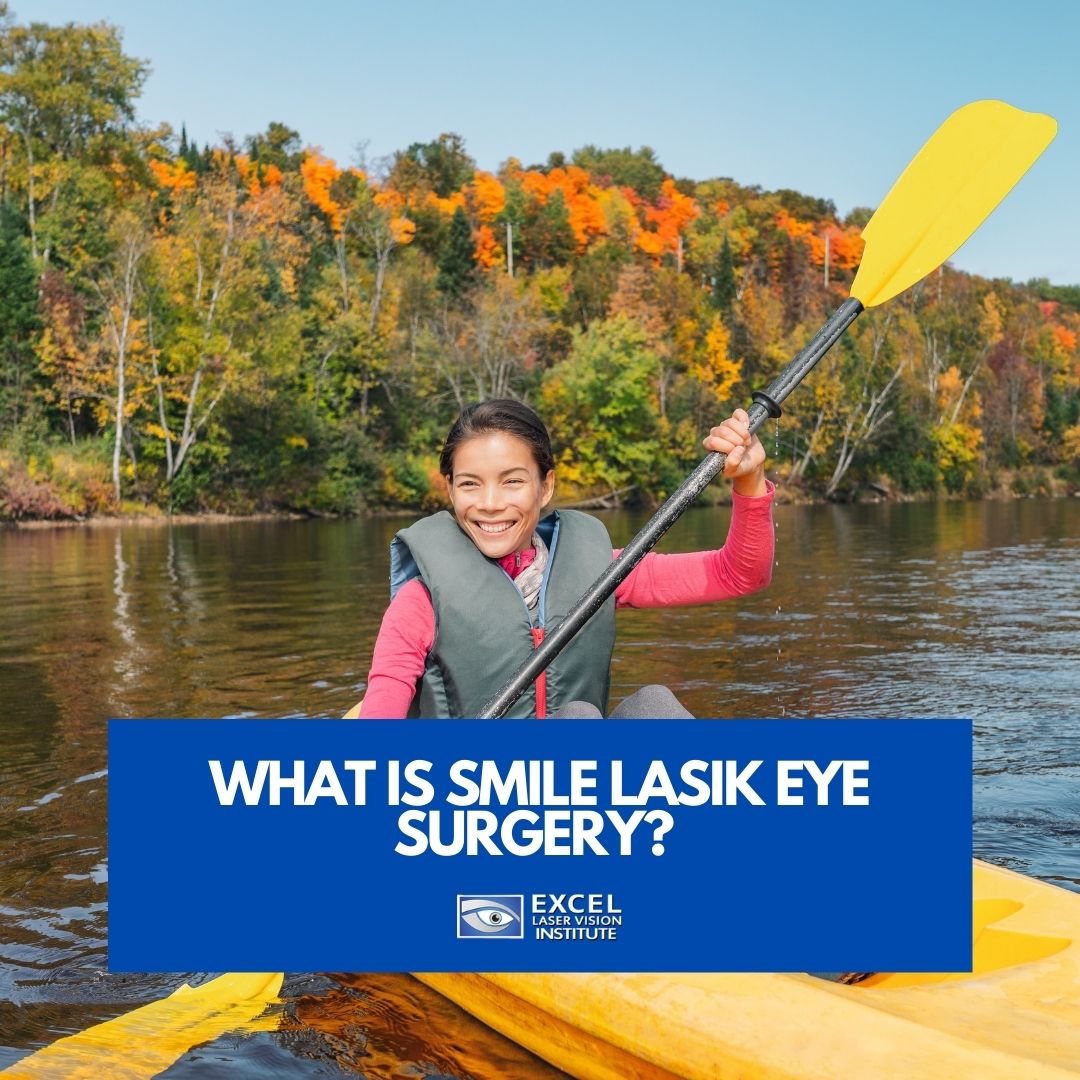
What is SMILE LASIK Eye Surgery?
If you have vision problems, then you may be looking into procedures like SMILE, LASIK eye surgery, and PRK. All of these are known for correcting refractive errors, but SMILE is the most significant advanced method of eye surgery technology that has been developed in the last ten years. Dr. Moosa, a top LASIK surgeon in Orange County says that SMILE is a one-step, one laser procedure that is considered even less invasive than LASIK!

What Is a SMILE Procedure?
First of all, SMILE is an acronym for “Small Incision Lenticule Extraction”. Also, it is the latest advancement in laser vision correction. According to Dr. Moosa, one of the leading SMILE and LASIK surgeons in Orange County, the SMILE procedure is an innovative laser eye surgery that is perfect for correcting myopia (nearsightedness).
The SMILE procedure is really easy and straightforward since it is a one-step laser eye surgery, generally performed by a VisuMax laser, which is non invasive. When your eye surgeon performs a SMILE procedure, he or she will use a computer-guided, highly focused light to cut a small incision in the cornea and will remove a tiny piece of corneal tissue, which is known as a lenticule. This helps to reshape the cornea and correct your vision.
This vision procedure combines the safety of already established vision correction techniques with more comfort and the possibility of greater accuracy.
SMILE is an Accurate Procedure
As Dr. Moosa of SMILE LASIK Orange County clinic explains, the cornea is made up of five layers. If the patient has eyesight focusing issues, the eye surgeon corrects this by only reshaping the stroma, which is the middle layer. The SMILE laser operates to apply several tiny bubbles to make the base of the lenticule, located in the lower part of the stroma, and then the top of the lenticule, which is situated in the upper part of the stroma.
The surgeon forms a small keyhole incision so they can access the stroma to remove the targeted piece of tissue to correct the patient’s vision. In just a matter of seconds, the cornea has been reshaped and the patient should receive excellent visual results. In short, SMILE vision correction is a pain-free keyhole procedure that a surgeon performs using a single advanced Zeiss laser.
SMILE Is Comfortable And Easy
SMILE doesn’t take too long since the actual laser part of the procedure is fast and completed in twenty-five seconds. SMILE is a very comfortable procedure. The tiny incision in your cornea generally heals in a couple of days and no stitches are required. Although not everyone experiences the exact same result, the majority of our patients have reported feeling amazing and being able to see better as soon as the very next day.
What Are The Benefits Of SMILE?
It is a less invasive surgery
Patients love SMILE because it is a less invasive procedure when compared to LASIK or PRK. During the LASIK procedure, the surgeon creates a flap to correct the patient’s vision, this flap is 20mm in circumference. During a PRK procedure, an 8mm diameter surface removal is made to correct vision. However, during a SMILE procedure, the surgeon only has to create a 3mm keyhole incision in the patient’s cornea. This tiny incision provides less disturbance to corneal nerves and more corneal stability after surgery.
No Flap Surgery
One of the disadvantages of the LASIK procedure is the formation of a permanent flap of corneal tissue. During LASIK, the surgeon creates a small flap of corneal tissue using a femtosecond laser which he or she folds back.
Then the surgeon uses a second laser, which is called an excimer laser to reshape the underlying corneal tissue and correct the patient’s vision. As a result, it is a more complex procedure than this new vision procedure, SMILE.
Additionally, it is good to know that LASIK is a very safe and reliable procedure.
Complications hardly ever occur, however when complications do arise, they are usually ‘flap related complications’ and are a result of the flap created during surgery. Considering the surgeon doesn’t have to create a flap during a SMILE procedure, there is definitely no risk of flap related complications.
SMILE enables people to have a safe and accurate procedure with a quick visual recovery.
If you’re wondering about SMILE LASIK surgery recovery, ophthalmologists have found that SMILE provides faster visual recovery since it only takes around one or two days to deliver optimal results. Plus, it’s just as accurate and safe as traditional LASIK.
SMILE is quiet, odorless, and blade-free
During the LASIK and PRK procedure, the surgeon uses a second laser called an excimer laser. Anyone who has done a LASIK or PRK procedure can confirm the loud ‘clicking’ noise the laser creates when used, which can be unsettling for some patients.
Additionally, the excimer laser is known for a distinct odor during a LASIK procedure, since it is used to vaporize corneal cells. On the other hand, SMILE does not use an excimer laser. Therefore the procedure is not only quieter, but odorless as well.
Less probability of dry eye syndrome
Some patients have dry eyes as a side effect of laser eye surgery. An advantage of SMILE is that it can lower the chance for dry eyes to occur. Since SMILE only consists of a tiny incision created in the cornea, there is only a slight possibility of dry eyes post-surgery.
If You are Not a Good LASIK Candidate, SMILE Might be an Alternative For You
In some cases, an eye surgeon will find that the patient is not suitable for LASIK. The three most common factors that make a patient not eligible for LASIK are the following:
- Patients who play action sports or have jobs with a lot of direct contact to the eyes such as fighters, boxers and so on.
- Susceptibility to dry eyes or chronic eye syndrome.
- Irregularly shaped or thin corneas.
To ascertain if a patient is suitable for a SMILE procedure, the optometrist will examine the patient’s eyes in the following way:
- Check the general health of the patient’s eyes
- Measure the cornea
- Check the pupil size
- Measure the amount of nearsightedness
Consult with your refractive surgeon for the SMILE, LASIK eye surgery, or PRK procedure that works best for you. Once you have an in-depth consultation, you will have a better idea of your eligibility. If you want further information about PRK, SMILE, or LASIK in Los Angeles, fill out our contact form or give Excel Laser Vision Institute a call at + (818) 907-8606 today.

Ten Things About SMILE
In Los Angeles, ophthalmologists recommend the SMILE procedure to some of their patients instead of LASIK. SMILE is actually an acronym that signifies “Small Incision Lenticule Extraction” and is the recent advancement in laser vision correction. Not many people know about SMILE, so the LASIK eye center in Los Angeles has noted down the ten most important facts you need to know about SMILE.

SMILE eye surgery is a less invasive procedure and supports the strength of the cornea
Although the incision your eye surgery will make in the cornea is smaller during a SMILE procedure, the invasion deep in the cornea is exactly the same as LASIK.
Eye doctors also believe that SMILE protects the strength of the cornea!
SMILE isn’t new
SMILE is over ten years old now, and many clinics have included it as another method of vision corrective surgery. Some surgeons have taken SMILE up, like the LASIK in Los Angeles clinic of Excel Laser Vision Institute. You will notice that eye surgeons who perform SMILE still do a lot of work with LASIK and ASLA. The reason for this is because some patients are not suitable candidates for SMILE.
SMILE cuts less corneal nerves
According to LASIK in Los Angeles surgeons, this is absolutely true! However, what does this mean for the patient? Some patients experience dry eyes after both SMILE and LASIK after the procedure because of cut nerves. However, through research studies, it is noticed that dry eyes after SMILE is less common than with LASIK. Furthermore, dry eye symptoms after surgery generally only occur when the surgeon is performing on a preoperative dry eye. Most qualified eye surgeons would never send their patients to surgery, whichever procedure, knowing there is a dry eye present. In studies, patients who undergo a SMILE procedure, usually experience fewer instances of dry eye symptoms after surgery.
SMILE is just as safe and accurate as LASIK
The safety and accuracy between SMILE and LASIK are very similar, however, SMILE proves to create fewer dry eye symptoms than LASIK as mentioned before. Also, corneal sensitivity heals quicker after SMILE compared to LASIK.
LASIK is a well-proven and advanced procedure, but it is at the end of its development. Therefore, there isn’t anything else that can be done to drastically improve LASIK procedures since it has reached the stage where lasers and results are very near to the variation in refraction.
On the other hand, SMILE is picking up momentum since patients prefer the approach of a small incision and no flap. Many eye surgeons will agree that SMILE is a better procedure because of the risk of ectasia and the common issue of post-op dryness with LASIK, as well as complications with the LASIK flap.
Is SMILE good for nervous patients?
A lot of eye surgery patients will tell you that the most uncomfortable part of the SMILE and LASIK procedures is the pressure that is placed on the eye to hold it still while the Femtosecond laser gets the job done. This is the part of the procedure that most patients have a tough time with. In LASIK the laser operates as quickly as ten seconds, on the other hand in SMILE it is longer since more corneal tissue is changed by the Femtosecond laser.
SMILE doesn’t need a blade
SMILE doesn’t need a blade, but neither does modern LASIK.
SMILE is a quiet and odorless procedure
This is an advantage of SMILE that has been reported by patients. In LASIK, there is a buzzing sound that lasts for about 4 seconds. Also, in LASIK there is an odor when the laser removes the corneal tissue which has a similar odor to burning hair. Whereas in SMILE since it does not use an excimer laser, the procedure is both quiet and odorless.
Visual Recovery – Which is faster LASIK or SMILE?
This question is a little tricky to answer with a straight answer since recovery time slightly varies. It is claimed that SMILE is faster since there is no ‘cut’ or flap made. Instead, the small incision in which the lenticule is removed heals very swiftly – usually by the end of the day or next.
Also, there is no risk of flap related complications, so patients can return to activities such as swimming, outdoor sports, and so on within the first week itself after a SMILE procedure. However, after a LASIK procedure, these energetic activities are generally allowed after 15 days to a month.
In spite of this, recovery can also imply visual recovery. There have been cases of LASIK patients that get comfortable with activities involving computer screen time far faster than those who have done SMILE. Even though patients who have done a SMILE procedure are allowed to use computers from the very next day of the procedure, with small breaks in between, there is evidence that SMILE patients take a bit longer to get comfortable with computer-related work.
Far-sighted patients aren’t good candidates for SMILE
If you suffer from long-sightedness or lower levels of short-sightedness, surgeons cannot treat it using SMILE.
If you are active, SMILE might be a better alternative
Most eye surgeons will inform their patients that if they live very active lifestyles, the main advantage that SMILE brings to the table over LASIK is that the cap might resist eye trauma a lot better. As mentioned above, mild to moderate eye trauma in sports could cause a LASIK flap problem.
Also, if you have a bad habit of rubbing your eyes hard, there is no risk of flap dislocation after a SMILE procedure since there is no flap involved. Therefore, if you are a person that usually rubs or knuckles your eyes, you are better off with a SMILE procedure. After a LASIK procedure, you have to be more careful when handling your eyes because the flap needs some time to settle in. That is why it takes about 15 days to a month to be allowed to do any active activities.
Consult with your refractive surgeon for the eye surgery procedure that works best for you. If you want further information about SMILE or LASIK procedures in Los Angeles, give Excel Laser Vision Institute a call at + (818) 907-8606 today.
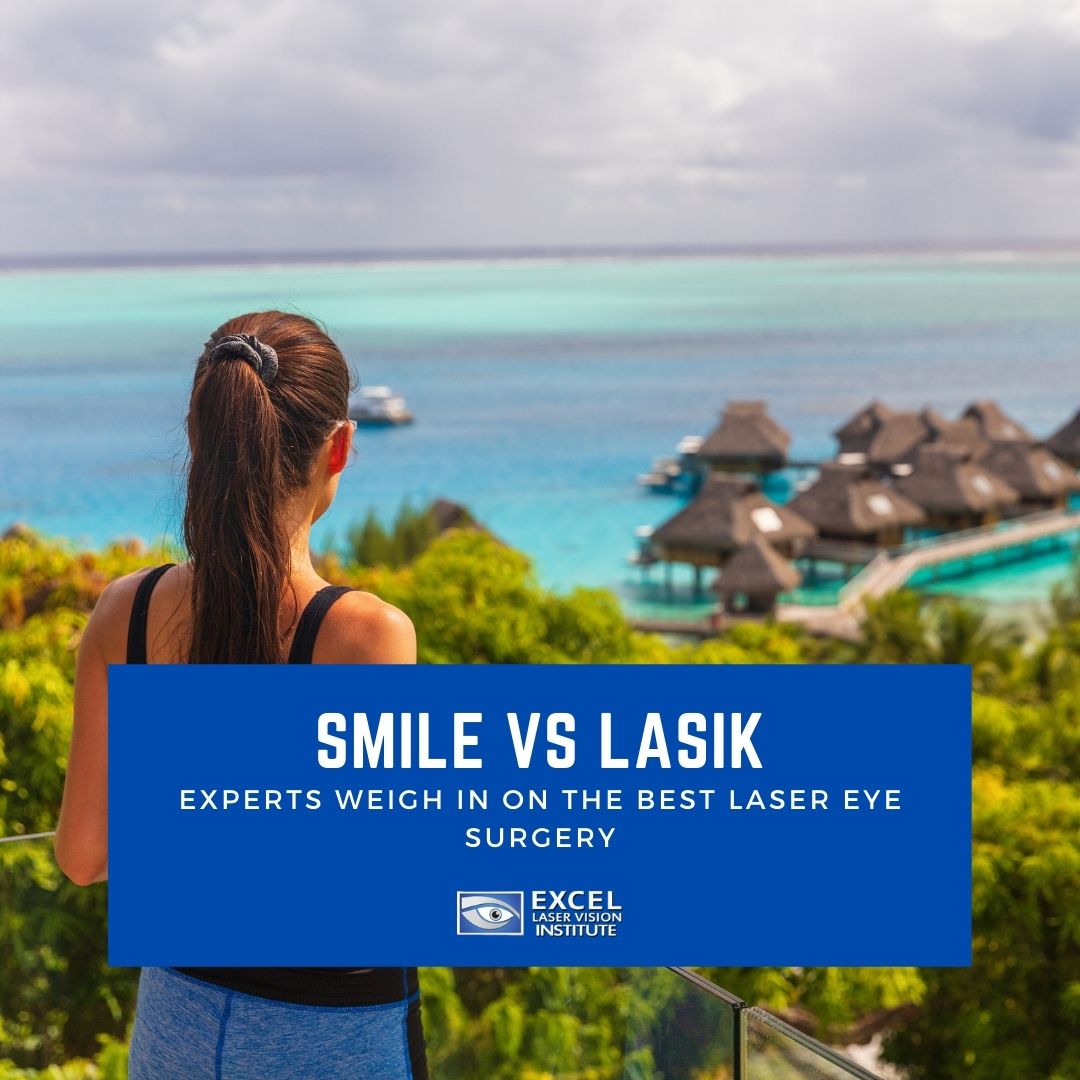
SMILE vs LASIK – Experts Weigh In On the Best Laser Eye Surgery
If you have nearsightedness, like many people in America, then you may be thinking about SMILE vs LASIK eye surgery. While both of these procedures deal with refractive errors, their treatments vary slightly in their method. You can get in touch with a LASIK surgeon in Orange County like Doctor Moosa to have them determine whether you are eligible for one or both of these options. LASIK is a widespread vision correction procedure that has gained high-esteem from medical professionals and patients alike. SMILE, while newer to the scene, is proving to be a very worthy competitor.
SMILE gained FDA approval for use in the United States in September 2016 and has achieved such satisfactory results as to create the ongoing SMILE Relex vs LASIK debate. Here are the essentials about SMILE laser eye surgery from the LASIK experts in Orange County.
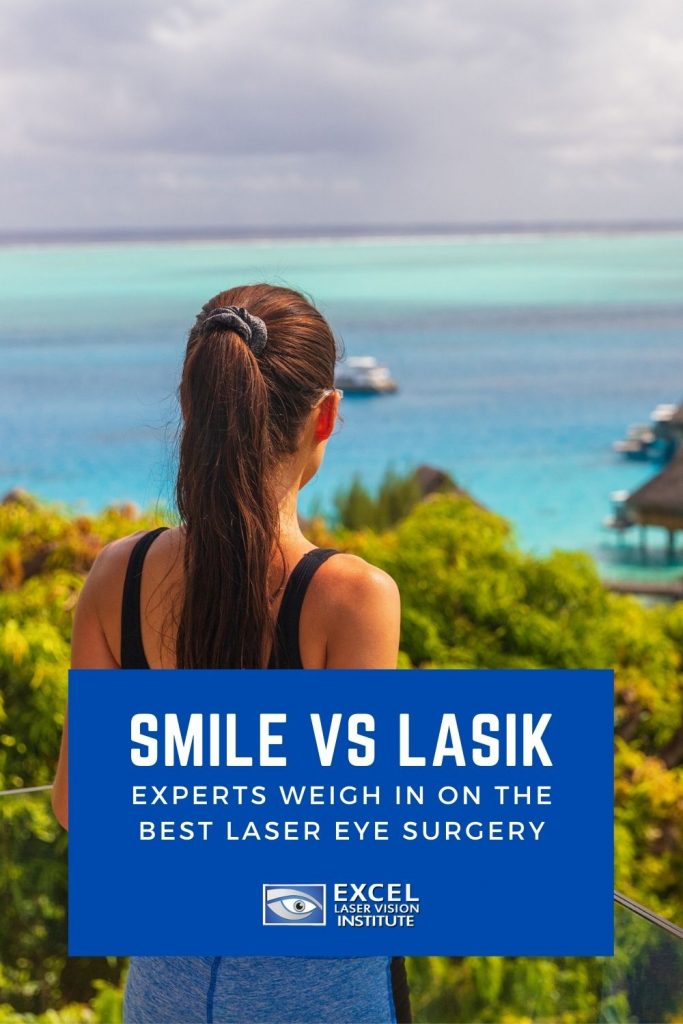
What Is SMILE Laser Surgery?
The word ‘SMILE’ is an acronym for Small Incision Lenticule Extraction, which is a lot to say in one go and not so easy to retain in our lexicon. SMILE laser eye surgery is performed by the lasik surgeon in Orange County using a VisuMax femtosecond laser.
During a SMILE procedure, the surgeon uses a femtosecond laser to create a small, lens-shaped piece of tissue, referred to as the lenticule within the cornea. Afterward, with the same laser, a small arc-shaped incision is made on the surface of the cornea, and the surgeon extracts the lenticule through this incision and disposes of it.
A lasik surgeon in Orange County explains that when the small lenticule is removed, the shape of the cornea changes, correcting nearsightedness. The incision created in the cornea heals within a few days without stitches, and sharper vision happens very rapidly.
SMILE laser eye surgery in Orange County can correct up to -10.00 diopters (D) of nearsightedness. To qualify for SMILE eye laser surgery, candidates must be at least 22 years old, have no more than -0.50 D of astigmatism, and their eyeglass prescription must be stable for at least 12 months.
When Is LASIK A Good Option?
For your eye surgeon to consider you as a good candidate for LASIK, a patient has to have enough corneal thickness. The reason for this is because a flap is created during the procedure. Therefore, a certain corneal thickness is needed and those with thin or irregular corneas cannot receive LASIK eye surgery. When an optometrist diagnoses a patient with thin or irregular corneas are usually better candidates for SMILE or PRK.
If a patient is prone to chronic dry eye symptoms, SMILE may be a better option. LASIK is notorious for having a higher risk for postoperative dry eye symptoms and can increase a patient’s previously chronic dry eye condition.
The Advantages Of SMILE
Studies have revealed that SMILE produces basically the same visual acuity as LASIK for the correction of nearsightedness, without the lasik surgeon Orange County having to create a LASIK style corneal flap.
A study with 328 participants who went through the SMILE procedure, had uncorrected visual acuity (UCVA) of 20/40 or better after surgery except one of them, and eighty-eight percent had UCVA of 20/20 or better.
Additionally, there is evidence of less risk of dry eye symptoms after SMILE, compared with LASIK. There may be a couple of reasons for this, such as SMILE takes place within the cornea without a large corneal flap, less corneal nerves are impacted by the procedure.
The tiny SMILE incision may also help the cornea have more biomechanical stability after SMILE, in contrast to its ability to keep its shape, particularly following trauma after LASIK.
Ultimately, if you have a high degree of nearsightedness, with LASIK there is a higher risk of requiring an enhancement procedure to obtain the clarity of vision a patient wants without glasses. There seems to be less risk of requiring another procedure after SMILE for correction of severe amounts of myopia, most likely since less dehydration of the cornea happens during the SMILE procedure.
What To Expect From A SMILE Procedure?
At the moment, SMILE laser eye surgery in Los Angeles and Orange County is the most advanced FDA-approved laser vision correction procedure. Here is what to expect from a SMILE procedure.
It Is A One-Step Laser Procedure
The key difference between SMILE and its predecessors is that it is a one laser procedure. PRK and LASIK utilize an excimer laser, but that is not the case in a SMILE procedure. Instead, your eye surgeon will use a femtosecond laser to cut a very small incision in the cornea and use it to remove a tiny piece of corneal tissue, the lenticule.
It Is Less Invasive Surgery
SMILE is a far less invasive laser eye surgery procedure than LASIK. During a LASIK procedure, your eye surgeon creates a flap that is 20mm in circumference. A PRK procedure creates an 8mm diameter surface removal. Nevertheless, a SMILE procedure only creates a 3mm corneal key-hole incision. This provides a more corneal stability post-surgery and less disruption to the corneal nerves during surgery.
It Is Quiet, Odorless, And Blade-Free
During a LASIK and PRK procedure, an excimer laser is used to reshape the cornea. While the eye surgeon is carrying on with the procedure, you will hear a clicking sound that creates an apparent odor. Because the excimer laser isn’t used in a SMILE procedure, it is quiet and odorless.
There Are No Flap-Related Complications
As a result of the surgeon not having to create a flap in a SMILE procedure like LASIK, there is no risk of flap-related complications after surgery.
There Is Safe, Accurate, And Fast Visual Recovery
Clinical trials that were carried out on SMILE revealed that it is just as safe and accurate as LASIK in Orange County.
What Are The Disadvantages Of Smile?
Although SMILE has a lot of benefits, there is one downside to this procedure. That disadvantage is that it is not yet available to treat farsightedness or astigmatism. Therefore, if you have nearsightedness, and your eye surgeon feels that it is the best option for you, then SMILE is for you!
Plus, visual recovery takes a little bit longer than LASIK. After a LASIK procedure, a patient can experience immediate visual recovery, whereas SMILE’s visual recovery can take about one to two days.
If you want to learn more about SMILE vs LASIK and want a solution for your nearsightedness, contact Excel Laser Vision Institute at + (818) 907-8606 today.

